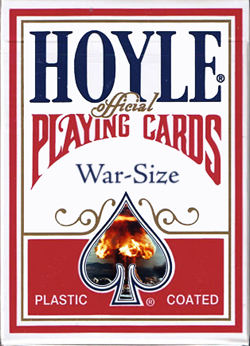Hoyle's Modernized Rules for War
 War is a basic card game most commonly played with children, although adults have been known to enjoy it, too. Widely recognized for its exciting, high-stakes battles, War is played avidly worldwide, though some criticize it for ultimately being drawn out and tiresome.
War is a basic card game most commonly played with children, although adults have been known to enjoy it, too. Widely recognized for its exciting, high-stakes battles, War is played avidly worldwide, though some criticize it for ultimately being drawn out and tiresome.
According to standard rules, the game is played with 52 cards. In recent years, however, it has been deemed acceptable, if not altogether more common, to engage in the game without a full deck.
Cards are ranked from high (Ace) to low (2). Suits are generally disregarded in War, having no bearing whatsoever on the value of a given card. These are the traditional basics.
But with time comes evolution, and some newer versions of the game defy these rules. For example: in one popular U.S. version of the game, Hearts have almost no value, while any card in a black suit is disproportionately powerful.
War most commonly involves two players. More complex versions may be played with multiple players so long as cards are distributed equally to all. (This is rarely the result, however.)
Players should not peak at their own cards, or at those of their opponent(s). Some players do not mind a bit of rule bending with respect to this, and often will employ tactics deemed disagreeable by other players.
Also, while it is frowned upon, it is entirely permissible under modern rules to announce that an opponent is holding a certain card even if he indeed is not.
Once the cards have been dealt, each player turns his top card face-up on the table. As a rule of thumb, the player who throws the higher card wins. Lower-tier cards are the least important, so don’t worry too much about losing a few. Higher-tier cards (e.g. Aces, Kings, and Queens ), while less common, are more powerful. Ultimately, these cards will control the game, despite their comparatively minimal involvement.
Usually, war is declared only when players throw identical cards. Exceptions can be made, however, if a player or players deem war necessary, and no valid reason need be provided.
If there is a war—and there inevitably will be—each player drops three cards face down, then plays one card face up against his opponent’s. In the event of a tie, the action is repeated until one side wins.
It is not advisable to continue to drop cards after having been defeated in a war, though some may still choose to do so—usually those with a seemingly expendable supply—in the hopes of regaining lost ground. Most experts agree such forced tactics are more often than not deleterious to the game’s overall result.
It is further recommended that participants not engage in more than one war at a time if they can avoid doing so, as cards can quickly diminish when warring on multiple fronts. The potential rewards are tempting, but likely not worth the risk undertaken.
The game is carried out in the manner delineated above until one side possesses all the cards, or declares himself victorious regardless of the number of cards in his hand.
It is rare but not entirely uncommon for a player to announce victory and/or defeat, yet still continue to play. War, after all, is a game, and is to be enjoyed first and foremost. It need not make absolute sense or be rulebound one hundred percent of the time.
One last tip: When playing War, remember to allow plenty of time for game completion—years, even—as there is an extremely high probability that it will go on this long. There is a slight possibility, too, that it will never end.
More progressive players might opt to set a time limit on the game’s duration. Avid aficionados tend to deride this tactic, though, as by default it sets a limit on the amount of fun that may be had during a given match.
These are the basic rules of War. They should serve only to establish a baseline for how the game is played—more theoretical than anything else. Please feel free to make up your own rules as you go along, too.
Now, go forth and War!






